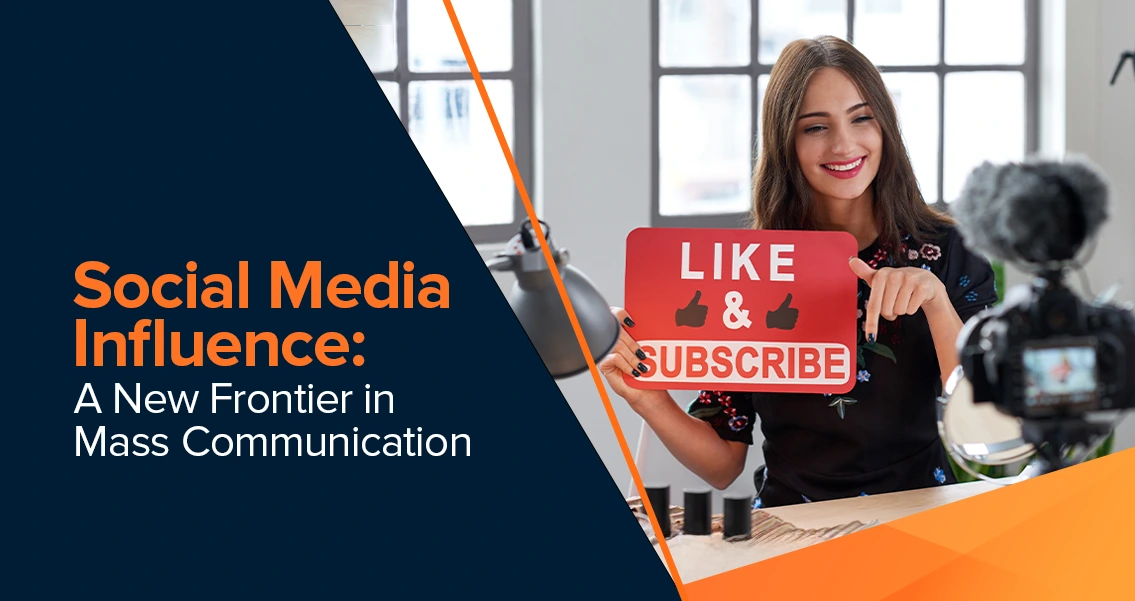Social Media Influence: A New Frontier in Mass Communication

Have you ever wondered what a world without memes, hashtags, and viral dances would look like? Well, neither have the 5.17 billion social media users across the globe in 2024! Imagine juggling not one, not two, but an average of 6.7 different social networks per month. That’s like attending a party where everyone speaks a different language; somehow, you're fluent in all of them!
In this whirlwind of likes, shares, and retweets, we find ourselves at the forefront of a new era in mass communication. Social media isn’t just changing how we chat with friends or stalk our favourite celebrities; it’s rewriting the rulebook on how information is spread and consumed.
Understanding this digital transformation is crucial for students pursuing an MA in Mass Communication colleges. This blog delves into the pivotal role of social media in shaping public discourse, the changes it has brought to traditional media channels, and how we adapt to these new dynamics at IMS Unison University (IUU).
The Role of Social Media in Mass Communication
Social media platforms like Facebook, Twitter, Instagram, and LinkedIn have transcended their original purposes of personal networking to become powerful tools for mass communication. These platforms allow instantaneous information sharing and enable users to reach a global audience within seconds. This immediacy and reach are why social media has become a primary tool for journalists, marketers, and communicators.
Moreover, social media's interactive nature allows for a two-way communication flow. Unlike traditional media, which typically offers a one-way communication stream, social media enables direct interaction between the content creators and the audience. This interaction fosters a more engaged and responsive communication environment where feedback is immediate and visible.
How Social Media is Changing the Communication Landscape
Social media has fundamentally altered the communication landscape in several key ways:
Expanding Reach
Social media breaks geographical barriers, enabling messages to reach international audiences. This global reach has transformed local news stories into global conversations and small-scale businesses into international brands.
Shifting Control
Control over information dissemination has shifted from a few media houses to the masses. Today, anyone with internet access can share news and opinions, which has democratised information and challenged traditional gatekeepers like newspapers and television networks.
Enhancing Engagement
The interactive capabilities of social media foster greater audience engagement. Users consume content and create and share it, actively participating in content distribution and commentary.
Real-Time Communication
The speed at which information spreads on social media is unmatched. This real-time communication can be a boon during emergencies or significant events, allowing for timely updates and widespread awareness.
Embracing Social Media in University Programs
Recognising the integral role of social media in contemporary mass communication, universities have integrated social media studies into their mass communication curriculums. Programs like the BA and MA in Mass Communication now cover digital journalism, social media analytics, and online content creation.
Student Projects
Practical experience is a cornerstone of these programs. Students engage in projects that require them to create and manage social media campaigns, analyse engagement data, and develop content strategies. These hands-on projects prepare students for real-world challenges and opportunities in mass communication.
Ethical Considerations in Social Media
As the power of social media continues to grow, so does the need for ethical guidelines in its use for mass communication. The viral nature of social media can sometimes lead to misinformation and the invasion of privacy.
Privacy and Accuracy
Respecting privacy while ensuring the accuracy of information shared on social media is paramount. Mass communication students are taught to verify information before sharing it and to understand the legal implications of breaching privacy.
Accountability
Social media platforms allow users to publish content anonymously or under pseudonyms, which can lead to a lack of accountability. University programs emphasise the importance of ethical journalism and communication, teaching students to maintain transparency and accountability, even in anonymous environments.
The Impact of Influencers on Social Media Communication
Influencers have become central figures in social media communication. They can sway public opinion, market products, and even impact political and social movements through their platforms.
Influencer Marketing
Courses in mass communication now often include modules on influencer marketing, analysing the strategies used by influencers to engage with their audiences effectively. This study examines the symbiotic relationships between brands and influencers and how these relationships are leveraged for marketing success.
Credibility and Persuasion
Students learn about credibility and ethical persuasion in communication, which is critical for understanding influencers' impact on their audiences. The curriculum explores how trust and authenticity play vital roles in the effectiveness of influencers.
Future Trends in Social Media and Mass Communication
Looking towards the future, social media is poised to continue evolving, bringing new trends and technologies that will further shape the field of mass communication.
Emerging Technologies
Virtual Reality (VR) and Augmented Reality (AR) are set to offer new ways for media professionals to engage audiences more immersively. Courses in advanced media technologies prepare students to use these tools effectively.
Artificial Intelligence in Social Media
AI is becoming increasingly important in analysing social media trends and consumer behaviour. Mass communication programs incorporate AI studies to help students understand and utilise these analytics tools for strategic communication planning.
Ethical AI Use
With AI’s growing role, ethical considerations are more critical than ever. Students are taught to consider the ethical implications of using AI in media, ensuring its application respects user privacy and promotes accurate information.
How IMS Unison University’s Mass Communication Program Can Help You Master Social Media
At IMS Unison University, the Mass Communication program is designed to equip students with a profound understanding of both traditional and new media. The curriculum includes comprehensive training in social media tools and strategies, emphasising critical thinking and ethical considerations in digital communication.
Program Highlights
- Digital Media Courses: Students learn about digital marketing, social media analytics, and content management systems.
- Interactive Learning: The program includes workshops and seminars with industry professionals, offering insights into the evolving media landscape.
- Career Preparation: The university provides career guidance and internship opportunities with leading media and communication firms to help students gain valuable industry experience.
Social media’s role in mass communication is not just a trend but a substantial shift in how information is shared and consumed. The programs at IMS Unison University and other MA in Mass Communication colleges continually evolve to keep pace with this dynamic field, preparing a new generation of communicators adept at using digital platforms to craft compelling narratives and engage with a global audience.
Conclusion
As the influence of social media on mass communication continues to grow, students and professionals alike must understand and harness its power effectively. Programs offered in the BA in Mass Communication are more relevant than ever, providing the necessary tools and knowledge to navigate and succeed in this new digital frontier.

